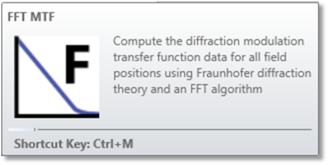FFT MTF


Computes the diffraction modulation transfer function (MTF) data for all field positions using an FFT algorithm.

Sampling The size of the ray grid used to sample the pupil. The sampling may be 32x32, 64x64, etc. Although higher sampling yields more accurate data, calculation times increase.
Show Diffraction Limit Select whether or not the diffraction limited data should be displayed.
Max Frequency Specify the maximum frequency (see "MTF Units") plotted.
Wavelength The wavelength number to be used in the calculation.
Field The field number to be used in the calculation.
Type Select either modulation, real, imaginary, phase, or square wave response.
Use Polarization If checked, polarization is considered. See "Polarization (system explorer)" for information on defining the polarization state and how polarization is used by analysis features.
Use Dashes Selects either solid lines or dashed lines to differentiate the various curves. This setting only applies to the Classic view, which is an option if "Enable Classic View" is selected in the Graphics tab of the OpticStudio Preferences.
Surface Selects the surface at which the MTF is to be evaluated. This is useful for evaluating intermediate images. See "Evaluating results at intermediate surfaces".
Discussion
Note: See the discussion sections of the FFT and Huygens PSF. Those comments also apply to this feature.
The diffraction MTF computation is based upon an FFT of the pupil data. The resulting MTF is the modulation as a function of spatial frequency for a sine wave object, although optionally the real, imaginary, phase, or square wave response is available. The Square wave MTF is the modulation response for a square wave target of the specific frequency, as opposed to the response to a sine wave target for the other plots. The square wave response is computed from the MTF data using the following formula:
where S(v) is the square wave response, M(v) is the sinusoidal modulation response, and v is the spatial frequency.
For focal systems, the cutoff frequency at any one wavelength is given by one over the wavelength times the working F/#. OpticStudio computes the working F/# at each wavelength for each field for the sagittal and tangential response separately. This yields accurate MTF data even for systems with anamorphic and chromatic distortion, such as those incorporating cylinders or gratings.
For afocal systems, the cutoff frequency is the exit pupil diameter divided by the wavelength.
The diffraction calculations are more accurate as the sampling increases, the peak-to-valley and maximum slope of the OPD decrease, and the transverse ray aberrations decrease. If the peak-to-valley OPD in the pupil is too great, then the wavefront sampling is too coarse and aliasing occurs. Aliasing will result in inaccurate data. OpticStudio will attempt to detect when aliasing occurs, and issue an appropriate error message. However, OpticStudio cannot automatically detect when the sampling is too low in all cases, especially in the presence of very steep slopes on the wavefront phase.
The FFT based MTF assumes a (reasonably) uniform distribution of rays on the exit pupil in cosine space to be accurate. Some systems, such as extremely fast off-axis reflectors, have dramatic stretching of the exit pupil and the FFT based MTF will thus be inaccurate. For these systems, the Huygens MTF should be used instead. For more information, see "Huygens MTF".
When the OPD in waves is large, such as more than 10 waves, it is probably a good idea to switch to geometric MTF instead of diffraction MTF. For these highly aberrated systems, the geometric MTF is very accurate, especially at low spatial frequencies (the higher frequency MTF falls off rapidly when aberrations are large). If shown, the diffraction limit curve is for the aberration free response at the reference field position; see "Diffraction limited".
The spatial frequency scale of the MTF plot is in cycles per mm in image space, or cycles per milliradian in object space (see "MTF Units"). MTF in cycles per mm is computed in image space, so any magnification of the system needs to be considered when determining spatial frequency response for object space.
The nature of the FFT algorithm is that the computation is done in pupil space coordinates. For this reason, rotating the image surface will have no effect on the orientation of the computed MTF. The tangential response corresponds to a periodic target oriented with lines along the object space X axis, and the sagittal response corresponds to a periodic target oriented with lines along the object space Y axis. This is different from the conventions of the "Geometric MTF" and the "Huygens MTF".
Next:


